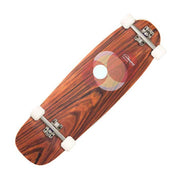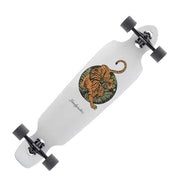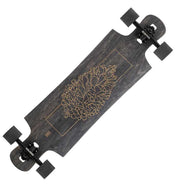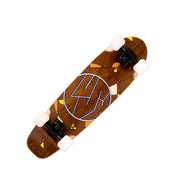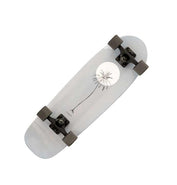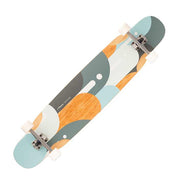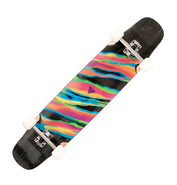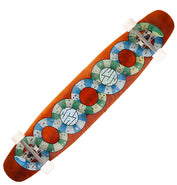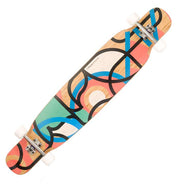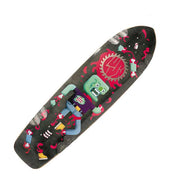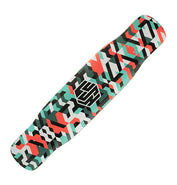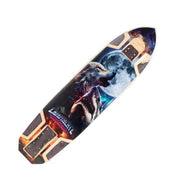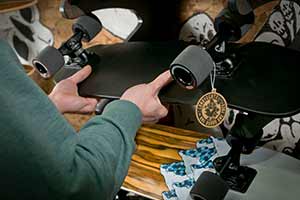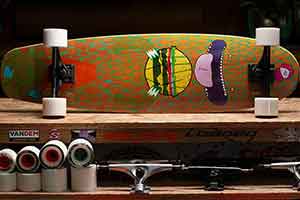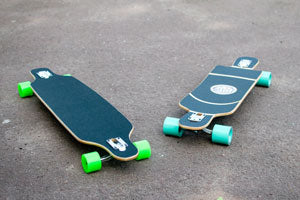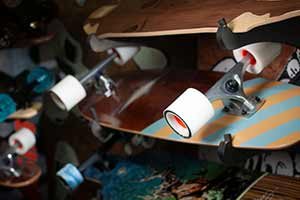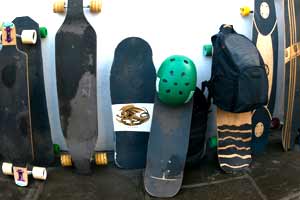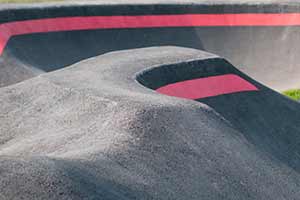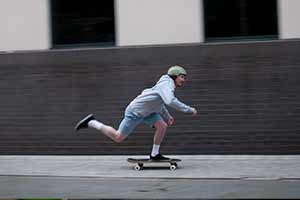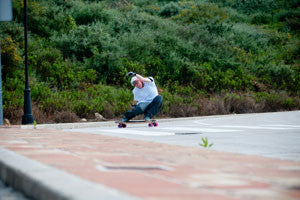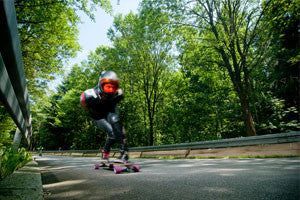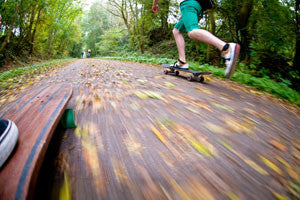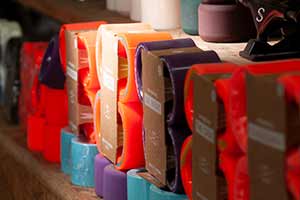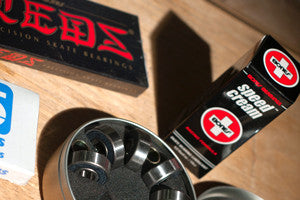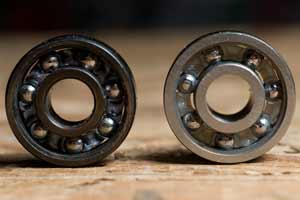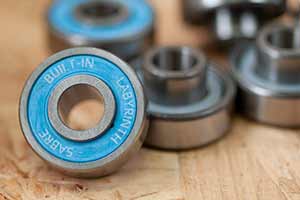Choosing the right longboard size
When it comes to longboards and cruiser boards, getting the size right is essential to getting the best longboarding experience.
For seasoned longboarders and cruisers, handling a board becomes second nature regardless of its size, but for newcomers it's more important to get the right size to fit you and your needs.
Unlike scooters rollerskates or rollerblades, the size of a longboard isn't just about the rider’s size.

HOW DO I CHOOSE THE RIGHT SIZE LONGBOARD OR CRUISER BOARD?
The main determining factors of a longboard's size (in order of importance) are:
- Length - Your height
- Width - Your shoe size
- What you want to use your board for
- Why is board size important anyway?
Unlike skateboarding, most long-boarders will not spend much time performing jumping tricks and flips however they will need to decide between bombing down steep inclines or weaving in and out of obstacles as they surf down the road on the way to school, work or wherever they have to get to.
1) CHOOSE YOUR BOARD BASED ON HEIGHT AND SHOE SIZE
Once you've figured out what kind of longboarding you are shopping for, it's time to take your body size into consideration.
There's no hard and fast rules here, but generally we would suggest that you base your longboard size decisions on:
- Length of the board based on your Height
- The Width of the board based on your (foot) Shoe Size
LENGTH - YOUR HEIGHT
Generally you can relate your height to the length of the skateboard or longboard you want.
Use the board size chart below as a rough guide to help you get started.
Bear in mind this is a rough starting suggestion only. Personal preference or skating style can easily result in different choices, so don't be afraid to break the mold!

| BOARD LENGTH | Children / Smaller Teenagers | Women / Smaller Adults / Lighter Adults | Large Adults / Heavier Adults |
| Cruiser Skateboard | 25-29.5" | 29.5-33" | 29.5-33" |
| Longboard Cruiser | 33-36" | 36-44" | 40-60" |
| Technical Dancing / Longboard Freestyle | 40-60" | 40-60" | 40-60" |
| Boardwalking / Footwork Dancing Tricks | 40-60" | 40-60" | 40-60" |
| Freeride/Downhill | 33-36" | 33-36" | 35-40" |
| Transition / Bowl Skating | 30-32" | 31-32" | 31-33" |
WIDTH - YOUR FOOT SIZE
Again this is a bit of a generalisation - but most people need to think a little bit about how big their feet are when determining the width of the board they need.
If you have smaller feet, then you'll benefit from a narrower deck.
This is mostly down to steering. For most kinds of skating, you need to be able to get your heels and toes to the rails of the deck to get proper leverage over the trucks. If you have smaller feet, you're likely to be a smaller person overall too, so you'll benefit from a lighter and more nimble deck, too.
So the simple way to figure out what width deck you need is to measure the length of your shoes, subtract around 1 1/2 - 2 inches or so, and take it from there.
And if you have bigger feet, simply put, you need more space for them!

| UK SHOE SIZE | BOARD WIDTH |
| 5-6.5 | 8.5" and narrower |
| 7-8.5 | 8.5" - 9" |
| 9-10 | 9" - 9.5" |
| 10.5-11.5 | 9.5" - 10" |
| 12 and over | 10"-10.5" or over 10.5" |
This table really isn't gospel truth, there's nothing stopping you skating an 8" wide deck if you have size 13 feet if that's what you prefer!
But it's a good place to start if you've never stepped on a skateboard or longboard before and don't know what you prefer.
2) WHAT ARE YOU USING YOUR BOARD FOR?
This is defintely the most important thing to consider.
Generally we would say that the kind of skateboarding or longboarding you want to do is more important than your height or shoe size when you are selecting a board for yourself.
Like everything on this page there are no hard and fast rules, and there's a lot more to a board than just length, width and wheelbase. But this should at least get you started.
CRUISING AND COMMUTING
There's a lot of diversity in cruiser board shapes. We would say that depending on your size, you could get away with anything from 27" right up to 44" long.
Any bigger than that and you'll just find the board to be a bit much to carry when you have to, and it's won't be maneuverable enough for most commuting/cruising situations.
We'd say go a bit shorter if you are going to be skating it for shorter distances, and longer for longer distances.
Longer boards are more comfortable, and shorter boards are more nimble. So that's the trade off you need to make.
"Stashability" is also something to consider. If you are skating to the bus stop or train station, and your commute involves a fair bit of carrying, then a shorter board is probably where it's at.
Likewise, if you have limited space to store your board at work, college or home, then smaller is probably better.
Board feel comes into this too. If you are just cruising around for the feeling of it rather than on a functional commute from A to B, then a longer board carves and flows better.
You should check out our Cruiser Skateboard Buyer's Guide for more, but generally we'd say that:
- If you want something for getting from A to B over a shorter distance, check out our Retro and Cruiser Skateboards
- A great alternative to a cruiserboard for bigger people, beginners and a more forgiving ride would be a small longboard.
- If you are looking to cruise it's own sake, or you have a bigger distance to cover, then you want a Longboard Cruiser instead.
- Kids and skaters who value small size for an easy carry at the expense of an easy skate can check out a Mini Cruiser.
CRUISING AND COMMUTING - CRUISER BOARDS
Cruiserboards are basically wider regular skateboards with soft wheels on. They're great for tighter urban environments, and perfect if you can already skate and need something to get from spot to spot.
Cruisers are smaller than longboards, so they're a great option if you don't have much space in your life or your journey involves some public transport.
CRUISING AND COMMUTING - SMALL LONGBOARDS
Easier to skate than a cruiserboard, but retaining many of the advantages that come with a smaller deck size, smaller longboards are a great shout for those looking to cruise.
Well-suited to kids and adults, you'll find drop-throughs, pintails and flat profile decks as well as the familiar double-kick skateboard shape in this category.
CRUISING AND COMMUTING - LONGBOARD CRUISERS
Full-sized longboards are the best option for any kind of distance. Super comfortable, more stable and available in a wide variety of shapes, a longboard remains the most functional tool for the job.
Longboards are the easiest to skate too, so they are very well suited to beginners.
CRUISING AND COMMUTING - KIDS BOARDS & MINI CRUISERS
Mini Cruisers are smaller than regular skateboards with soft wheels and narrow trucks. They're great for kids looking to start their skateboard journey.
Adults can get away with minicruisers too, but their small size can make them a bit tricker for beginners.
Check our Skateboards For Kids page for more ideas on what makes a good kid's board!
DANCING AND BOARDWALKING
This is where longer boards really come into their own!
You need a lot more deck space for a dancer/boardwalker.
Boards start at around 45" and go right up to 60"+!
Generally speaking, you need to balance flip tricks vs footwork.
Flip tricks (shuvits, ollies etc) are easier on shorter, lighter boards.
Footwork (boardwlaking, pirouettes/spinners, peter pans etc) are much easier on a bigger board.
Check out our Longboard Dancing and Freestyle Setups guide for more on that!
FREERIDE AND DOWNHILL
This is all about stability.
Downhill boards have got a lot shorter over the years. But it's the length of your wheelbase that's more important here, rather than the overall lenth of the board.
As noses and tails are less important for this kind of skating, you can slam the trucks right at the ends of the deck and have a board that's relatively stable for it's size.
We'd suggest that the faster you go, the longer your wheelbase needs to be. Check out our Downhill Skateboarding Buyers Guide for more.
If you're more into sliding and technical downhill skating, then shorter might be better for you, to a point. Check out our Freeride and Sliding Guide for more on that.
SKATEPARKS AND TRANSITION
For transition, bowl and pool skating, you are looking at a much smaller range of lengths, wheelbases and widths.
Generally, if you're just looking to blast around a bowl without really doing anything techie (flips and stuff), then you should be looking at a wider deck - 9" or even more.
Wider decks often have a slightly longer wheelbase too, which is good for stability but require a good deal more agression to get the most out of.
If you want to keep your flips and you are hitting the streets occasionally, then a narrower deck is the way to go.
You can use our "Deck Width" filter to find exactly the size you want on our OldSchool, Reissue and Retro boards selection.
3) WHY DOES SIZE MATTER?
What does changing the size of a skateboard or longboard actually do?
Understanding a few simple concepts will go a long way towards helping you choose the right longboard.
LONGER BOARDS:
- Are Heavier
- Have more room to stand on, which makes them more suited to total beginners
- Offer less turn (although this can be negated by setting up your trucks differently)
- Are way more Stable
- Are way nicer to carve on
- Are more comfortable, especially if they have a bit of flex
- Are harder to chuck around - kickturns, ollies etc are much more difficult
SHORTER BOARDS:
- Are Lighter
- Have less room to stand on, which makes them more suited to advanced skaters
- Generally offer more turn and less stability
- Are way nicer to carve on
- Are more comfortable, especially if they have a bit of flex
- Are easier to kickturn, ollie etc
WIDER BOARDS:
- Are Heavier
- Have more room to stand on
- You have more leverage over the trucks with a narrow board. So depending on your truck setup, they can actually be MORE turny, as you are putting less force through the bushings.
- More prone to wheelbite
NARROWER BOARDS:
- Are Lighter
- Have less room to stand on
- You have less leverage over the trucks with a narrow board. So depending on your truck setup, they can actually be LESS turny, as you are putting less force through the bushings.
SHORTER WHEELBASES ARE:
- Less Stable at Speed
- More Turny and Responsive
- Grippier
- Less forgiving whilst sliding
LONGER WHEELBASES ARE:
- More Stable at Speed
- Less Turny and Responsive
- Slidier
- More forgiving whilst sliding and drifting
What next?
Now that you've got an idea about what size board you need, check out our longboard buyer's guides below for more info or head over to the Longboard and Skateboard Completes section of the shop!
If you're still stuck, get in touch via the chatbox, WhatsApp phone or email, and we'll be stoked to help you out!



